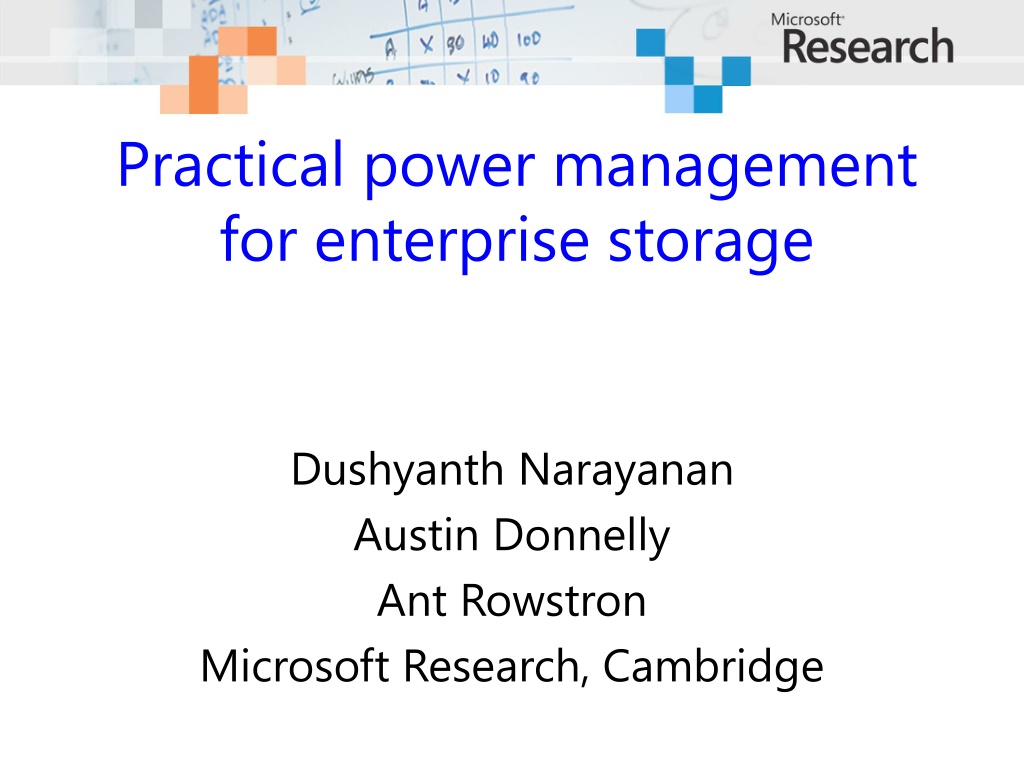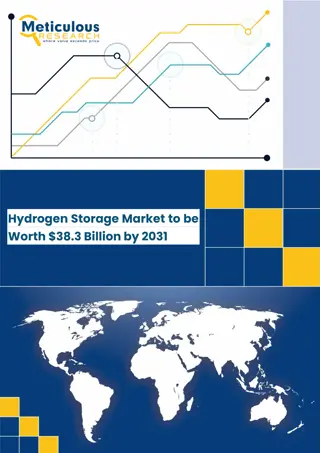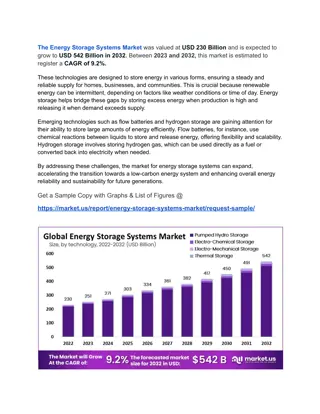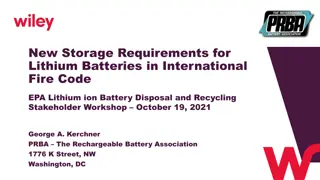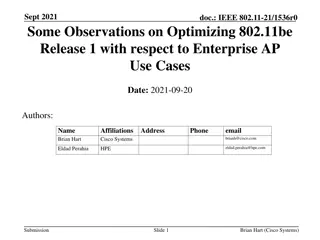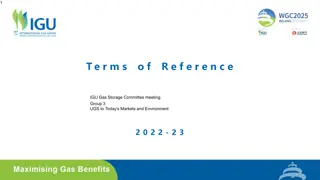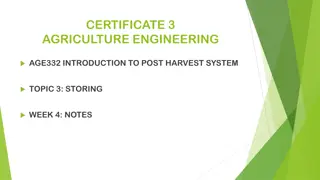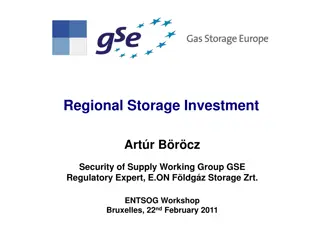Practical Power Management for Enterprise Storage
Energy in data centers is a significant expense, with storage being a major consumer. The challenge lies in reducing energy consumption, especially during idle periods. Strategies like spinning down disks when not in use and offloading writes from idle volumes can help optimize power usage in enterprise storage setups.
Download Presentation

Please find below an Image/Link to download the presentation.
The content on the website is provided AS IS for your information and personal use only. It may not be sold, licensed, or shared on other websites without obtaining consent from the author. Download presentation by click this link. If you encounter any issues during the download, it is possible that the publisher has removed the file from their server.
E N D
Presentation Transcript
Practical power management for enterprise storage Dushyanth Narayanan Austin Donnelly Ant Rowstron Microsoft Research, Cambridge
Energy in data centres Substantial portion of TCO Power bill, peak power ratings Cooling Carbon footprint It s (becoming) a big deal for Microsoft Our own data centres Enterprise customers Microsoft Research Summer School 2008 2
Saving energy in storage Storage is significant energy consumer Especially in an idle system Idle Seagate Cheetah 15K.4: 12 W Mostly to keep spindles spinning Idle Intel Xeon dual-core: 24 W Can be improved Microsoft Research Summer School 2008 3
Challenge Most of disk s energy just to keep spinning 17 W peak, 12 W idle, 2.6 W standby Other technologies not quite there yet Flash too expensive Low-power disks have lower performance And still have spinning spindles Need to spin down disks when idle Microsoft Research Summer School 2008 4
Small/medium enterprise DC FS1 10s to100s of disks Not MSN search Heterogenous servers File system, DBMS, etc RAID volumes High-end disks Vol 0 Vol 1 FS2 Vol 0 Vol 1 Vol 2 DBMS Vol 0 Vol 1 Microsoft Research Summer School 2008 5 5
Intuition Small/medium enterprise workloads have Diurnal, weekly patterns Idle periods Write-only periods Reads absorbed by main memory caches We should exploit these Convert write-only to idle Spin down when idle Microsoft Research Summer School 2008 6
Design principles Incremental deployment Don t rearchitect the storage Keep existing servers, volumes, etc. Work with current, disk-based storage Flash more expensive/GB for at least 5-10 years If system has some flash, then use it Assume fast network 1 Gbps+ Microsoft Research Summer School 2008 7
Write off-loading Spin down idle volumes Offload writes when spun down To idle / lightly loaded volumes Reclaim data lazily on spin up Maintain consistency, failure resilience Spin up on read miss Large penalty, but should be rare Microsoft Research Summer School 2008 8
Roadmap Motivation Traces Write off-loading Evaluation Microsoft Research Summer School 2008 9
How much idle time is there? Is there enough to justify spinning down? Previous work claims not Based on TPC benchmarks, cello traces What about real enterprise workloads? Traced servers in our DC for one week Microsoft Research Summer School 2008 10
MSRC data center traces Traced 13 core servers for 1 week File servers, DBMS, web server, web cache, 36 volumes, 179 disks Per-volume, per-request tracing Block-level, below buffer cache Typical of small/medium enterprise DC Serves one building, ~100 users Captures daily/weekly usage patterns Microsoft Research Summer School 2008 11
Idle and write-only periods 30 Number of volumes 25 80% 14% 20 15 10 Mean active time per disk Read-only Read/write 21% 47% 5 0 0 20 40 60 80 100 % of time volume active Microsoft Research Summer School 2008 12
Roadmap Motivation Traces Write off-loading Preliminary results Microsoft Research Summer School 2008 13
Write off-loading: managers One manager per volume Intercepts all block-level requests Spins volume up/down Off-loads writes when spun down Probes logger view to find least-loaded logger Spins up on read miss Reclaims off-loaded data lazily Microsoft Research Summer School 2008 14
Write off-loading: loggers Reliable, write-optimized, short-term store Circular log structure Uses a small amount of storage Unused space at end of volume, flash device Stores data off-loaded by managers Includes version, manager ID, LBN range Until reclaimed by manager Not meant for long-term storage Microsoft Research Summer School 2008 15
Off-load life cycle Reclaim Probe Write Invalidate Read Write v1 Spin up Spin down v2 Microsoft Research Summer School 2008 16
Consistency and durability Read/write consistency manager keeps in-memory map of off-loads always knows where latest version is Durability Writes only acked after data hits the disk Same guarantees as existing volumes Transparent to higher/lower layers Microsoft Research Summer School 2008 17
Recovery: transient failures Loggers can recover locally Scan the log Managers recover from logger view Logger view is persisted locally Recovery: fetch metadata from all loggers On clean shutdown, persist metadata locally Manager recovers without network communication Microsoft Research Summer School 2008 18
Recovery: disk failures Data on original volume: same as before Typically RAID-1 / RAID-5 Can recover from one failure What about off-loaded data? Ensure logger redundancy >= manager k-way logging for additional redundancy Microsoft Research Summer School 2008 19
Roadmap Motivation Traces Write off-loading Experimental results Microsoft Research Summer School 2008 20
Energy savings 100 Vanilla Machine-level off-load Rack-level off-load 90 80 Energy (% of baseline) 70 60 50 40 30 20 10 0 Worst day Microsoft Research Summer School 2008 Best day 21
Energy by volume (worst day) Rack-level off-load Machine-level off-load Vanilla 30 Number of volumes 25 20 15 10 5 0 0 20 40 60 80 100 Energy consumed (% of baseline) Microsoft Research Summer School 2008 22
Response time: 95th percentile 0.7 Response time (seconds) Baseline Vanilla Machine-level off-load Rack-level off-load 0.6 0.5 0.4 0.3 0.2 0.1 0 Best day Read Worst day Read Best day Write Worst day Write Microsoft Research Summer School 2008 23
Response time: mean 0.25 Baseline Vanilla Machine-level off-load Rack-level off-load Response time (seconds) 0.2 0.15 0.1 0.05 0 Best day Read Worst day Read Best day Write Worst day Write Microsoft Research Summer School 2008 24
Conclusion Need to save energy in DC storage Enterprise workloads have idle periods Analysis of 1-week, 36-volume trace Spinning disks down is worthwhile Large but rare delay on spin up Write off-loading: write-only idle Increases energy savings of spin-down Microsoft Research Summer School 2008 25
Questions? Microsoft Research Summer School 2008 26
Testbed 4 rack-mounted servers 1 Gbps network Seagate Cheetah 15k RPM disks Single process per testbed server Trace replay app + managers + loggers In-process communication on each server UDP+TCP between servers Microsoft Research Summer School 2008 27
Workload Open loop trace replay Traced volumes larger than testbed Divided traced servers into 3 racks Combined in post-processing 1 week too long for real-time replay Chose best and worst days for off-load Days with the most and least write-only time Microsoft Research Summer School 2008 28
Configurations Baseline Vanilla spin down (no off-load) Machine-level off-load Off-load to any logger within same machine Rack-level off-load Off-load to any logger in the rack Microsoft Research Summer School 2008 29
Storage configuration 1 manager + 1 logger per volume For off-load configurations Logger uses 4 GB partition at end of volume Spin up/down emulated in s/w Our RAID h/w does not support spin-down Parameters from Seagate docs 12 W spun up, 2.6 W spun down Spin up delay is 10 15s, energy penalty is 20 J Compared to keeping the spindle spinning always Microsoft Research Summer School 2008 30
Related Work PDC Periodic reconfiguration/data movement Big change to current architectures Hibernator Save energy without spinning down Requires multi-speed disks MAID Need massive scale Microsoft Research Summer School 2008 31
Just buy fewer disks? Fewer spindles less energy, but Need spindles for peak performance A mostly-idle workload can still have high peaks Need disks for capacity High-performance disks have lower capacities Managers add disks incrementally to grow capacity Performance isolation Cannot simply consolidate all workloads Microsoft Research Summer School 2008 32
Circular on-disk log HEAD TAIL H ........ 8 7 1 2 7 8 9 4 X X X 1 2 X X ........ 7-9 Write Reclaim Spin up Microsoft Research Summer School 2008 33
Circular on-disk log Header block Tail Nuller Stale versions Null blocks Active log Reclaim Head Invalidate Microsoft Research Summer School 2008 34
Client state Microsoft Research Summer School 2008 35 35
Server state 36 Microsoft Research Summer School 2008 36 36
Mean I/O rate 200 180 Requests / second 160 140 Read Write 120 100 80 60 40 20 0 0 1 2 0 1 2 3 4 0 1 0 1 0 1 2 0 1 0 1 2 0 1 2 0 1 0 0 1 2 3 0 1 0 1 2 3 usr proj prn hm rsrchprxy src1 src2 stg ts web mds wdev Microsoft Research Summer School 2008 37
Peak I/O rate 5000 4500 Requests / second 4000 3500 Read Write 3000 2500 2000 1500 1000 500 0 0 1 2 0 1 2 3 4 0 1 0 1 0 1 2 0 1 0 1 2 0 1 2 0 1 0 0 1 2 3 0 1 0 1 2 3 usr proj prn hm rsrchprxy src1 src2 stg ts web mds wdev Microsoft Research Summer School 2008 38
Drive characteristics Typical ST3146854 drive +12V LVD current profile Microsoft Research Summer School 2008 39 39
Drive characteristics Microsoft Research Summer School 2008 40 40
